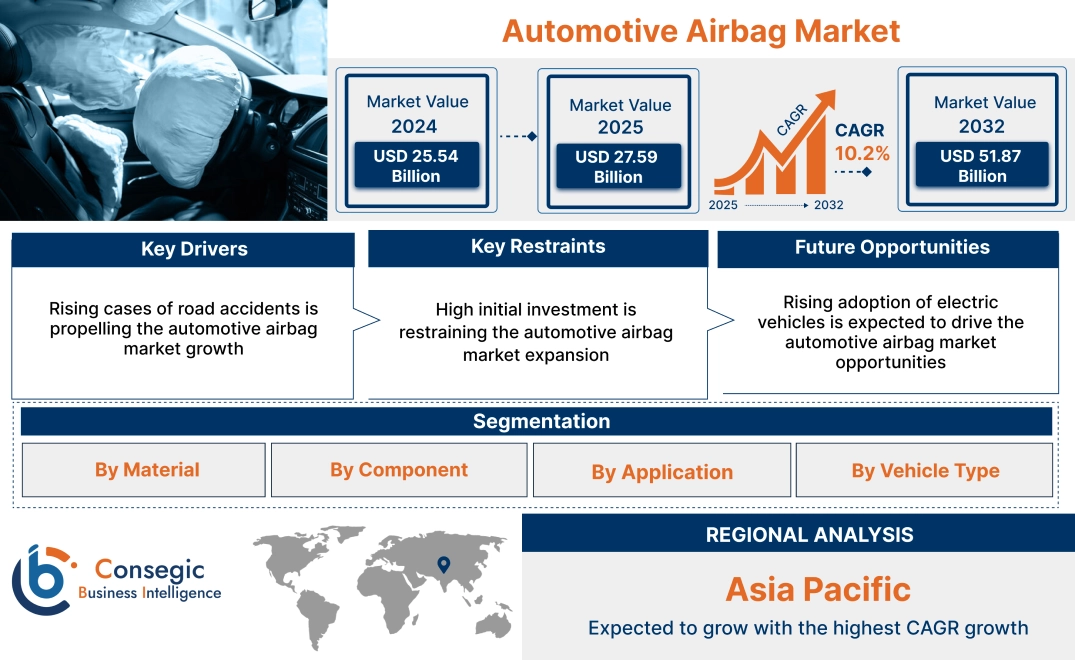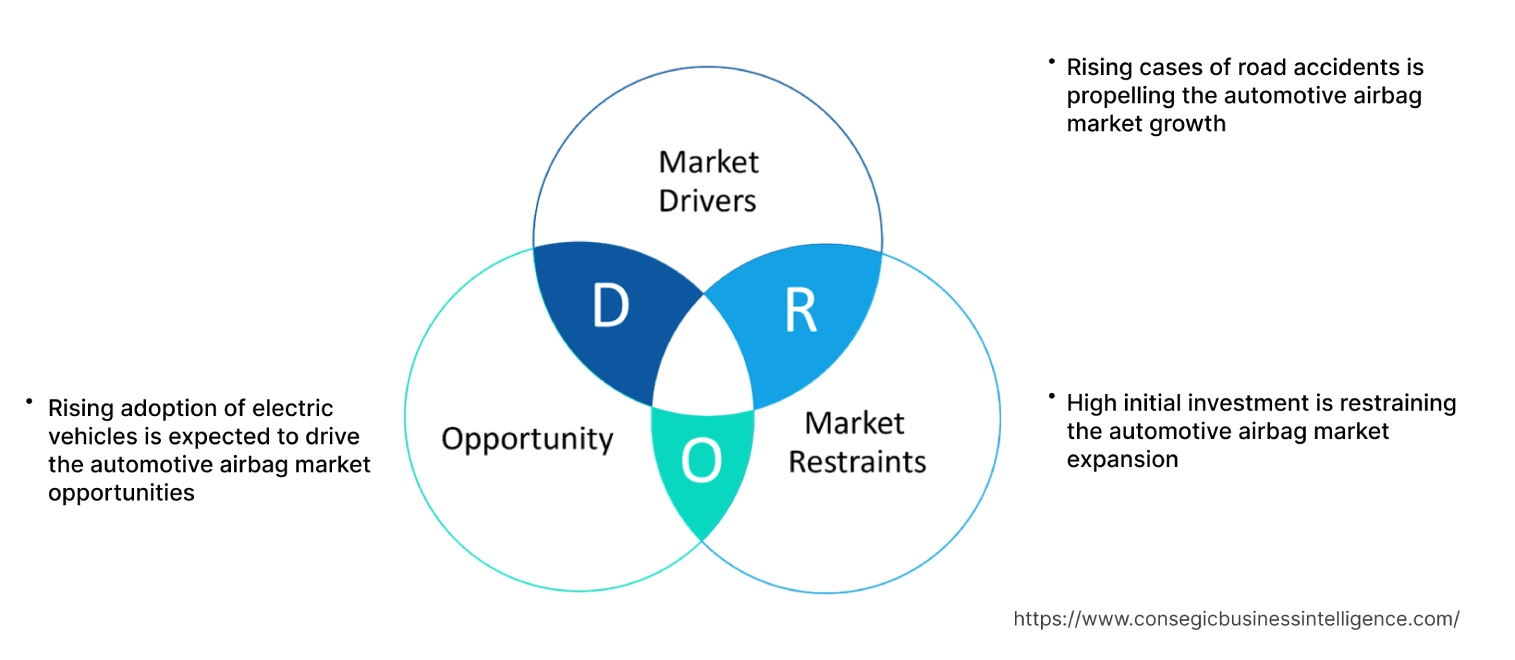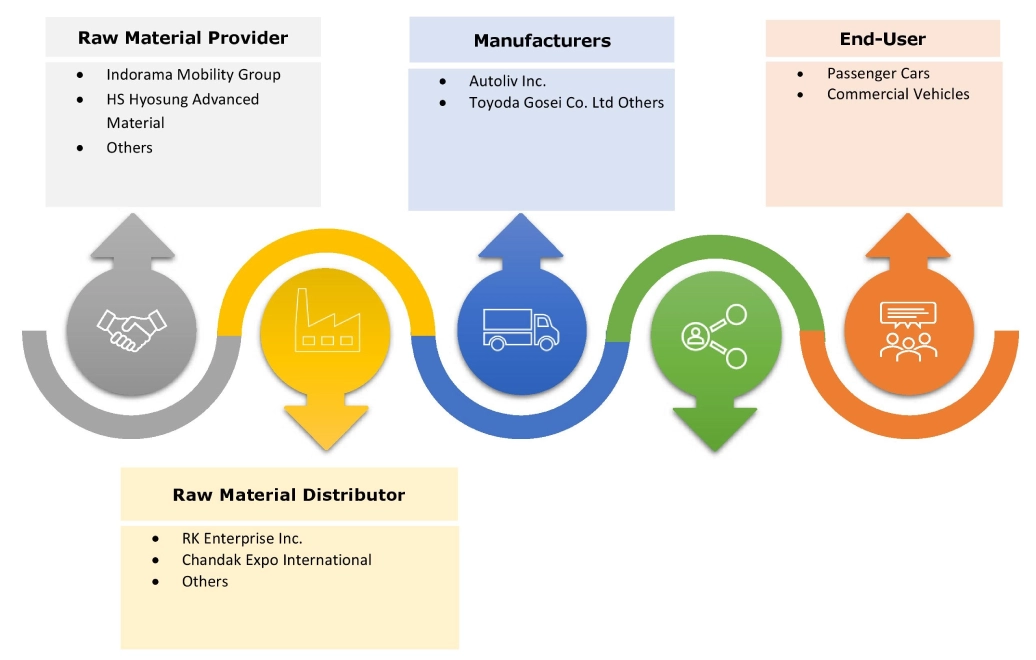- Summary
- Table Of Content
- Methodology
Automotive Airbag Market Size:
Automotive Airbag Market size is estimated to reach over USD 51.87 Billion by 2032 from a value of USD 25.54 Billion in 2024 and is projected to grow by USD 27.59 Billion in 2025, growing at a CAGR of 10.2% from 2025 to 2032.
Automotive Airbag Market Scope & Overview:
Automotive airbag system utilizes a bag designed to inflate in milliseconds during a collision and then deflate afterwards. Moreover, automobile airbag system consists of a flexible fabric bag, airbag cushion, impact sensor and an inflation module. Airbags usually inflate after a sensor detects a front-end crash that is severe enough for triggering its deployment. Additionally, the rising need for improved vehicle safety is increasing the integration of airbag system in passenger vehicles and commercial vehicles.
Key Drivers:
Rising cases of road accidents is propelling the automotive airbag market growth
The rising cases of road accidents and increasing fatalities are driving the demand for enhanced vehicle safety solutions including automobile airbag system. Airbags system includes built-in cushions that inflate when a frontal collision occurs with a vehicle for safeguarding the individuals inside the vehicle. Air bags usually inflate after a sensor detects a front-end crash that is severe enough for triggering its deployment, which further reduces the impact on the driver while lowering the risk of severe injury during an accident. As a result, the rising cases of road accident is further driving the need for automobile airbag system.
- For instance, according to the National Highway Traffic Safety Administration, approximately 3,308 individuals in the United States were killed while nearly 289,310 individuals were injured in vehicle crashes involving distracted drivers in 2022.
Therefore, as per the analysis, the rising cases of road accidents is driving the demand for automotive airbags for improved safety, in turn proliferating the automotive airbag market size.
Key Restraints:
High initial investment is restraining the automotive airbag market expansion
High initial investment associated with the integration of airbag systems is among the primary factors restraining the market. The upfront costs associated with airbag systems including costs of hardware components, and others along with integrating them into vehicles can be significantly high, which may cause financial barriers, particularly for smaller businesses or individuals operating on tighter budgets.
Additionally, manufacturing and integrating advanced airbag systems with high-end technology for improved safety can significantly increase the production costs for automobile manufacturers. Hence, high initial investments associated with manufacturing and integration of airbags in vehicles are restraining the market.
Future Opportunities :
Rising adoption of electric vehicles is expected to drive the automotive airbag market opportunities
Factors including the prevalence of stringent automotive emission regulations, rising consumer preference for sustainable transportation, along with availability of subsidies and tax rebates are leading to significant adoption of electric vehicles (EVs). Moreover, modern EVs are often integrated with airbag system for increasing occupant safety, particularly during vehicle collisions and accidents, which is providing lucrative aspects for market growth.
- For instance, according to International Energy Agency (IEA), the overall sales of electric car reached approximately 14 million in 2023, among which China, Europe and United States accounted for 95% of the total sales.
Hence, as per the analysis, the rising adoption of electric vehicles is projected to increase the integration of airbags in modern EVs, in turn driving the automotive airbag market opportunities during the forecast period.
Automotive Airbag Market Segmental Analysis :
By Material:
Based on material, the market is segmented into polyester fiber, nylon, and others.
Trends in the material:
- Rising advancements associated with polyester fiber-based airbags, attributing to its several benefits such as lightweight, increased durability, moisture resistance, and lower cost among others.
- There is a rising trend towards utilization of recycled fabrics in airbag production to reduce carbon footprint and facilitate sustainable manufacturing.
The nylon segment accounted for the largest revenue in the overall market in 2024.
- Automobile airbag is primarily composed of nylon woven fabric usually made of Nylon6.6/66, which can be coated or uncoated.
- Nylon fabrics are among the most common fabrics used for making airbag cushions, which involve three separate assemblies combining to form the finished end product, the airbag module. Moreover, nylon fabric used in airbags must be flame resistant and impermeable to gases.
- For instance, Toray Industries Inc. operates an automotive airbag nylon fiber and fabric business in its Mexican subsidiary, Toray Advanced Textile Mexico. The subsidiary comprises of manufacturing facilities that produces nylon fibers for airbags.
- According to the automotive airbag market analysis, rising development of nylon fabric for automobile airbag applications is driving the automotive airbag market size.
The polyester fiber segment is anticipated to register fastest CAGR growth during the forecast period.
- Polyester fiber is becoming increasingly popular as alternative to polyamide/nylon in automobile airbags.
- Moreover, polyester fiber offers a range of benefits such as lightweight, increased durability, sunlight resistance, resistance to wrinkles, moisture resistance, and lower cost among others.
- For instance, in June 2024, Autoliv introduced airbags composed of 100% recycled polyester, which significantly decreases the greenhouse gas footprint of airbags.
- Therefore, increasing advancements associated with vehicle airbags made of polyester fiber are anticipated to propel the market during the forecast period.
By Component:
Based on component, the market is segmented into airbag inflator, diagnostic monitoring unit, crash sensor, and others.
Trends in the component:
- Factors including rising automobile sales, increasing cases of road accidents and significant concerns regarding vehicle safety are driving advancements in automobile airbag components.
- Increasing advancements related to airbag inflators for deploying airbags in event of a collision and facilitating improved safety.
The airbag inflator segment accounted for the largest revenue share in the total automotive airbag market share in 2024, and it is anticipated to register substantial CAGR growth during the forecast period.
- Airbag inflators are designed for producing a certain quantity of gas, with a specific temperature, composition, and controlled rate. Airbag inflators are used for filing the automobile airbag system to adequately cushion a vehicle occupant.
- Moreover, airbag inflator is a vital component of automobile airbag system, which is primarily used for deploying airbags in case of a collision.
- For instance, Autoliv Inc. is an automobile airbag manufacturer that offers a broad range of airbag inflators in its product offerings. Autoliv offers several types of airbag inflators including pyrotechnic inflators, cold gas inflators, and hybrid inflators.
- Therefore, the rising advancements associated with automobile airbag inflators are expected to drive the automotive airbag market growth during the forecast period.
By Application:
Based on application, the market is segmented into frontal position, side position, side curtains, rear position, and knee position.
Trends in the application:
- Favourable government measures mandating the installation of airbag systems in passenger vehicles is driving its integration in frontal and side positions.
- Rising integration of airbags in side position to cushion and spread the impacts load for preventing occupant body parts from sustaining concentrated impact forces.
Frontal position segment accounted for the largest revenue in the overall automotive airbag market share in 2024, and it is anticipated to register significant CAGR growth during the forecast period.
- Airbags integrated in frontal positions are designed to improve occupant protection in an event of a frontal collision.
- Frontal airbags are designed to supplement the seat belts and they are optimized to work only in a moderate-to-severe frontal collision.
- For instance, Honda offers frontal airbag system in its product offerings, which is designed for improving passenger safety. The frontal airbag design aims at reducing traffic injuries and fatalities in wider range of frontal collisions
- Therefore, the rising integration of frontal airbag systems in automobiles for improved safety is driving the automotive airbag market trends.
By Vehicle Type:
Based on the vehicle type, the market is segmented into passenger vehicle, light commercial vehicle, and heavy commercial vehicle.
Trends in the vehicle type:
- Factors including the rising disposable income, growing popularity of luxury cars, and progressions in autonomous driving systems are key aspects propelling the passenger cars segment.
- Factors including the rising sales of heavy-duty vehicles, growing investments in commercial vehicles, and increasing need for economical modes of transportation and logistics are primary determinants for driving the commercial vehicles segment.
Passenger cars segment accounted for the largest revenue share of 49.32% in the total market share in 2024, and it is anticipated to register substantial CAGR growth during the forecast period.
- Automobile airbags are primarily used in passenger vehicles for increasing occupant safety, particularly during vehicle collisions and accidents.
- Moreover, the integration of automobile airbags in passenger cars can assist in lowering the impact on occupants and prevent fatal injuries in an event of vehicle collision or accident.
- For instance, according to the International Organization of Motor Vehicle Manufacturers, the total passenger car production in America reached up to 5,146,607 units in 2023, representing an increase of nearly 8% from 4,784,773 units in 2022.
- According to the analysis, the rising production of passenger cars is propelling the automotive airbag market trends.
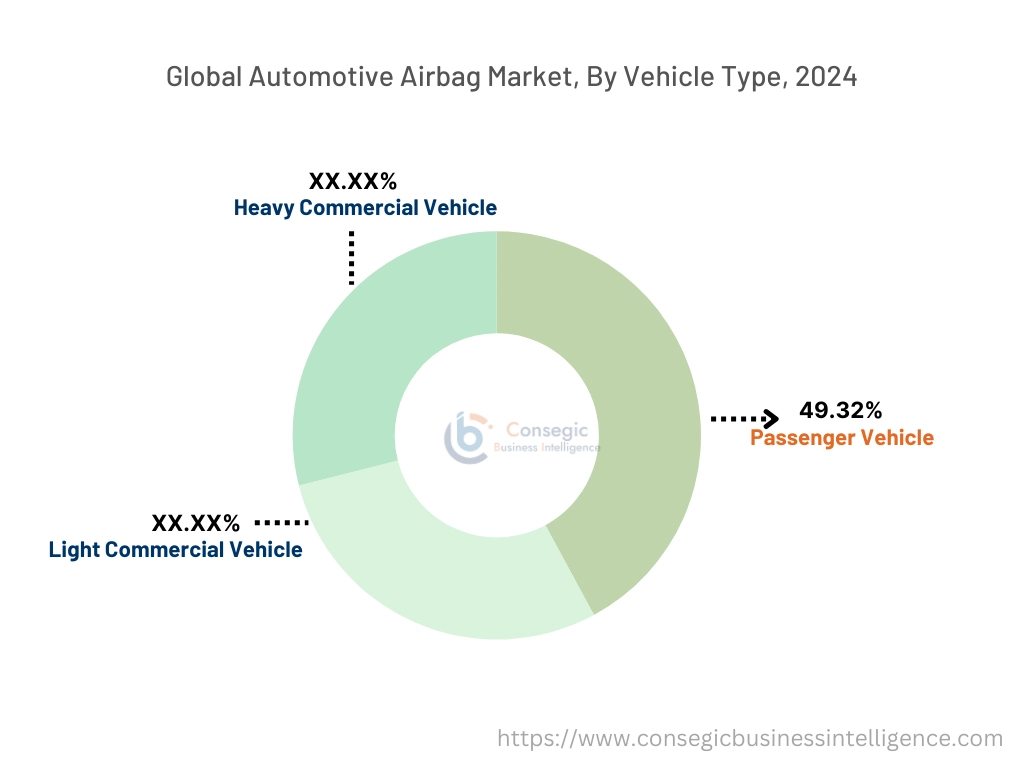
Regional Analysis:
The regions covered are North America, Europe, Asia Pacific, the Middle East and Africa, and Latin America.
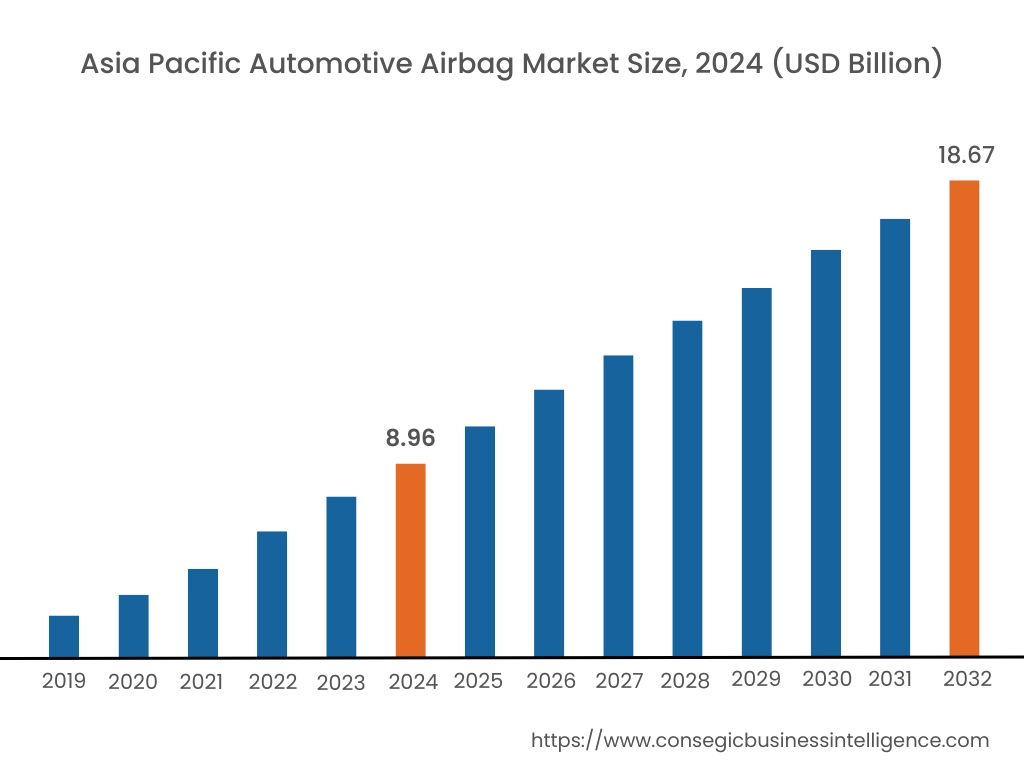
Asia Pacific region was valued at USD 8.96 Billion in 2024. Moreover, it is projected to grow by USD 9.70 Billion in 2025 and reach over USD 18.67 Billion by 2032. Out of this, China accounted for the maximum revenue share of 38.21%. As per the automotive airbag market analysis, the adoption of automobile airbags in the Asia-Pacific region is primarily driven by increasing government investments in automotive sector, rising automobile production, and increasing adoption of electric vehicles. Additionally, the rising advancements associated with passenger cars and increasing integration of airbag system in modern vehicles are further accelerating the automotive airbag market expansion.
- For instance, according to the Society of Indian Automobile Manufacturers (SIAM), the total production of passenger cars in India reached 49,01,844 units during FY 2023-24, representing an incline of 7% in comparison to 45,87,116 units during FY 2022-23. The above factors are further propelling the market demand in the Asia-Pacific region.
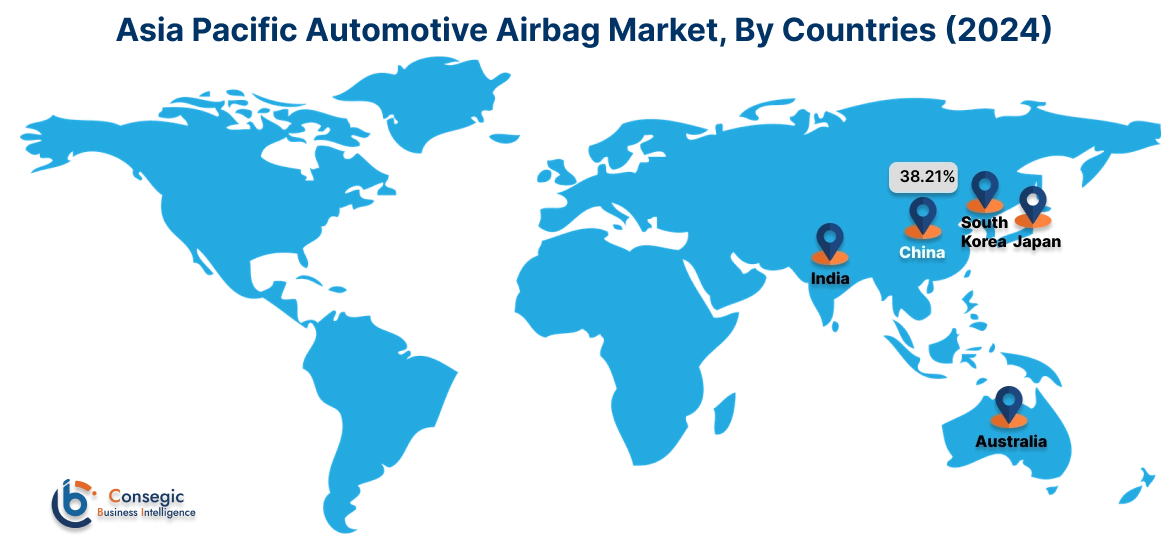
North America is estimated to reach over USD 14.05 Billion by 2032 from a value of USD 6.99 Billion in 2024 and is projected to grow by USD 7.55 Billion in 2025. In North America, the growth of automotive airbag industry is driven by rising production of automobiles and increasing adoption of electric vehicles (EVs) in the region. Similarly, rising advancements associated with electric vehicles and autonomous vehicles are further contributing to the automotive airbag market demand.
- For instance, according to the International Energy Agency, the total sales of battery electric vehicles (BEVs) in the United States reached 1.1 million units in 2023, demonstrating a substantial increase from 0.8 million units in 2022. The above factors are projected to boost the market demand in North America during the forecast period.
Additionally, the regional analysis depicts that the increasing vehicle production, advent of electro mobility, and favorable government measures for integration of advanced safety system in modern vehicles are propelling the automotive airbag market demand in Europe. Furthermore, as per the market analysis, the market demand in Latin America, Middle East, and African regions is expected to grow at a considerable rate due to factors such as growing automotive sector and increasing investments in electric vehicles among others.
Top Key Players and Market Share Insights:
The global automotive airbag market is highly competitive with major players providing products to the national and international markets. Key players are adopting several strategies in research and development (R&D), product innovation, and end-user launches to hold a strong position in the automotive airbag market. Key players in the automotive airbag industry include-
- Ashimori Industry Co., Ltd. (Japan)
- Autoliv Inc. (Sweden)
- Toyoda Gosei Co. Ltd (Japan)
- Continental AG (Germany)
- Denso Corporation (Japan)
- Hyundai Mobis Co. Ltd (South Korea)
- Joyson Safety System (China)
- Nihon Plast Co., Ltd. (Japan)
- Robert Bosch GmbH (Germany)
- ZF Friedrichshafen AG (Germany)
Recent Industry Developments :
Product Launch:
- In July 2024, Hyundai Mobis introduced its first airbags that are specifically customized for purpose-built vehicles. The airbags consider the distinctive characteristics of purpose-built vehicle, which usually has a spacious interior along with versatile design options.
- In June 2024, ZF Friedrichshafen developed automobile airbag for facilitating advanced automated driving. The airbag is developed to provide increased safety in the event of a crash.
Automotive Airbag Market Report Insights :
| Report Attributes | Report Details |
| Study Timeline | 2019-2032 |
| Market Size in 2032 | USD 51.87 Billion |
| CAGR (2025-2032) | 10.2% |
| By Material |
|
| By Component |
|
| By Application |
|
| By Vehicle Type |
|
| By Region |
|
| Key Players |
|
| North America | U.S. Canada Mexico |
| Europe | U.K. Germany France Spain Italy Russia Benelux Rest of Europe |
| APAC | China South Korea Japan India Australia ASEAN Rest of Asia-Pacific |
| Middle East and Africa | GCC Turkey South Africa Rest of MEA |
| LATAM | Brazil Argentina Chile Rest of LATAM |
| Report Coverage |
|
Key Questions Answered in the Report
How big is the automotive airbag market? +
The automotive airbag market was valued at USD 25.54 Billion in 2024 and is projected to grow to USD 51.87 Billion by 2032.
Which is the fastest-growing region in the automotive airbag market? +
Asia-Pacific is the region experiencing the most rapid growth in the automotive airbag market.
What specific segmentation details are covered in the automotive airbag report? +
The automotive airbag report includes specific segmentation details for material, component, application, vehicle type, and region.
Who are the major players in the automotive airbag market? +
The key participants in the automotive airbag market are Ashimori Industry Co., Ltd. (Japan), Autoliv Inc. (Sweden), Toyoda Gosei Co. Ltd (Japan), Continental AG (Germany), Denso Corporation (Japan), Hyundai Mobis Co. Ltd (South Korea), Joyson Safety System (China), Nihon Plast Co., Ltd. (Japan), Robert Bosch GmbH (Germany), ZF Friedrichshafen AG (Germany), and others.
